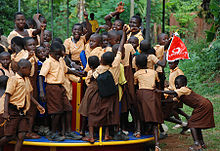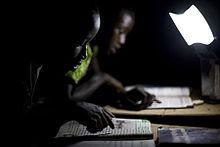- Empower Playgrounds
-
Empower Playgrounds Inc. 
Motto Lighting the World with Recess Formation March 2007 Type Non-profit Organization Headquarters Provo, UT Location United States, Ghana Official languages English Key people Ben Markham (founder, president) Website [5] Empower Playgrounds, Inc. is a US based 501(c)3 public charity that has developed electricity-generating playground equipment for use in rural third-world communities with drastically low rural electrification rates.[1] The mission of EPI is to use this play equipment, along with hands-on science kits, to enhance educational opportunities for children. Because the areas in which EPI works are predominantly subsistence agriculture communities, the children often work on family farms or at other chores until sundown; and because neither their schools nor their homes are equipped with electricity, it is very difficult for these children to do homework or develop study habits. The sustainable energy and culturally-sensitive education modules provided by EPI endeavor to bring these children light and learning where other means have struggled or failed to do so. Donor-provided funding is the monetary mechanism by which EPI is able to achieve their goals.
Contents
Technology
Play
The EPI system currently includes a power generating merry-go-round, with glider swing and other equipment currently being field tested. The platform merry-go-round allows many children to ride while a few take turns pushing. The generation train starts with a hub bearing to which the entire deck of the merry-go-round is attached. A drive shaft from the hub connects to a helical gearbox operating as a speed-increaser. The high-speed output shaft then turns a permanent rare earth magnet windmill generator. The efficiency of this generator is over 70%.
The electricity generated by the merry-go-round and all other play equipment in the EPI system is carried by underground wires to a power enclosure, created by SuReAl Group,[2] where it is converted to direct current and used to charge a large AGM deep cycle battery (much like those found in golf carts). In the enclosre, a state-of-the-art MPPT (maximum power point tracking) power controller effectively manages the charging and discharging of the storage batteries, protecting against drainage and ensuring long battery life.
A thirty watt solar panel is also connect to the power enclosure for educational purposes and to prevent battery discharging during school breaks. The CIGS (Copper /Indium/ Gallium/ Selenide) solar panel provides about 20% of the total system energy when school is in session.
The idea of converting the kinetic energy of children’s play into the electrical energy that powers their homes is a resourceful and innovative idea, yet not as simple as it sounds mechanically. Nevertheless, EPI maintains that their equipment is not a work wheel. An eight to twelve year old child playing vigorously on the equipment can output about 100 watts of energy. Because this is relatively very little energy, it requires a highly efficient system to ensure that nothing is lost. At the same time, attempting to capture all of the power coming in from the playground can lead to the “work wheel” effect in which the mechanisms of the playground are heavy or hard to maneuver. There are two methods of avoiding this: first, only convert a portion of the children’s play into electricity, or second, allow th child to vary how hard he/she plays. The current EPI playground equipment includes a combination of these two methods. On the merry-go-rounds, only a portion of children’s play is converted into electricity, whereas with the glider swing the children choose how hard to play by varying how hard they pump their feet. In this way, EPI maintains that its playground equipment is efficient enough to remain playful for the children while still producing a useful amount of power from their energy expended at recess.
Light
Energizer Battery Corporation, an EPI sponsor, has developed and currently supplies the smart LED lanterns used in EPI systems. This custom-designed lantern has a nickle-metal hydride (NiMH) battery pack capable of providing children’s studies with over 40 hours of bright light between recharges. One specific thing that sets the EPI smart LED lanterns apart from other such lanterns is the chip found within each that manages recharging from the large storage battery, as well as power to the LED bulbs. Lighting equivalent to a 25 watt light bulb. The lantern service life is expected to be greater than five years.
Learn
Without much access to government-provided electricity or school supplies, the teaching of science within rural villages is often abstract or theoretical. This makes it difficult for children to learn basic concepts as foundations of further learning.
Thus, in the Spring of 2009, an EPI intern travelled to Ghana for three months to meet with the Ghanaian Ministry of Education, elementary education developers, and the students and teachers of rural villages to assess the exact needs that were not being met. It was subsequently decided that the EPI playground equipment could work as a quality lab for teaching general mechanics, physics, energy transfer, and other basic principles of science. For instance, by showing the children the conversion of power to electricity it provides an effective demonstration of scientific principles.[3] With the help of many involved, EPI created a science kit and science lessons that correlated the with established Ghanaian education curriculum and which are culturally particular to the Ghanaian people.
In the spring of 2010, two more interns from EPI travelled to Ghana to test the science kits and train teachers on their use. Much of the equipment utilized in the EPI science labs are local materials that students and teachers would not have trouble getting access to on their own in the village. For those materials that would be difficult to find or too expensive to purchase, EPI donates the materials with the agreement that they are only to be used for teaching the students. Some materials include:
* Solar ovens * Thermometers * Masking tape * Measuring tape * Meter stick * Small plastic gears * Magnets * Compasses * Iron filings * Hand generators * Coiled wire * Batteries * Small solar cells * Light bulbs * Switches
The average cost of an EPI system (which includes school selection, manufacturing costs, shipping fees, science lab, teacher training, and installation) is 7000 USD.
Scholarships
In the summer of 2010, EPI began its scholarship program for promising young children that attend EPI-sponsored rural schools, and who have benefited from the EPI equipment. With the help of this scholarship, one student from rural Ghana is now attending high school, an opportunity not available otherwise. This scholarship program is in its beginning stages but hopes to extend to many students per year in the future.
Timeline
EPI was founded in 2007 by retired chemical engineer and Vice-President of Engineering at ExxonMobil Research and Engineering, Ben Markham. While living in Ghana, Africa, Markham observed the physical darkness of rural homes and school classrooms. He also saw the scarcity of play equipment in schoolyards. Touched by the children of these areas, Markham thought, “What if a portion of the playful energy from these children could be harnessed? What if that energy could become light for their classrooms and homes?”
With help from Brigham Young University, engineering expertise and social know-how was applied to create an innovative and viable solution: playground equipment that generates electricity from children’s play.[4] The concept was field tested and improved in Ghana in 2008. Kweku Anno, of Anno Engineering in Accra, Ghana converted the design to utilize materials readily available in Ghana. After a rigorous process of school selection involving EPI social scientists and the Ghanaian ministry of Education, Anno Engineering manufactured and installed the systems.
Initially, EPI hand modified LED camping lanterns so they could be recharged by the EPI system. In 2009, Energizer became a sponsor for EPI, donating their development of a smart LED lantern specifically designed for the EPI service.[5] The smart lantern has a computer chip that manages both the charging of the custom battery pack and the operation of the special LED lights. Lighting equivalent to a 25 watt light bulb for over 40 hours is provided by each recharge. Lantern life is expected to be around 5 years. In 2009-2010, EPI began including hands-on science kits to accompany their playground equipment.
Today, EPI power-generating play equipment is functioning successfully in sixteen rural schools, reaching over 3,000 students across many villages, including one rural island village off the coast of Ghana. Despite the success of EPIs initiatives, they are careful not to expand too quickly so as to ensure that the villages in which they are already functioning are not neglected for the sake of "progress." Still, in coming years, EPI intends to unroll improvements and extensions to their playground equipment and science curriculum. Through future partnerships, EPI also endeavors to extend its reach beyond Ghana to other parts of Africa and the developing world.
Collaborations
Numerous organizations are contributing to the development and implementation of this idea, including:
In 2010, PlayWorld Systems began a partnership with EPI in which PlayWorld utilizes their design and manufacturing expertise to create the energy-generating playgrounds, and EPI works to install and maintain them around the world.
SuReAl Group has been integral in the initiation and build up of Empower Playgrounds, helping to advance their technology and encouraging their eco-friendly endeavors.
- Energizer Battery, Inc.
Energizer has created a tailor-made lantern to work with the Empower Playgrounds equipment.
- The Ira A. Fulton College of Engineering and Technology
- The Masters in Public Administration Program at Brigham Young University in Provo, Utah
- Brigham Young University - Idaho
- GMH Engineering, Inc.
GMH assisted EPI in some of its earliest stages when EPI recognized that there wasn't sufficient power input from children and needed to maximize the power conversion efficiency. GMH confirmed the very high efficiency of the Ginlong generator and pointed EPI toward a Maximum Power Point Tracking controller. GMH input also convinced EPI to find a gearbox, not try to speed increase with chains/belts and pulleys. GMH continues to be a partner of ideas with EPI.
EPI worked with Rocketship on the prototype and production engineering of its lighting devices. It was their engineer who first concluded the Energizer camping lantern was very close to what EPI needed. Rocketship did some work on a custom design light for EPI, but that stopped when Energizer agreed to build one for EPI.
- Miller & Carr Attorneys-at-Law
- PowerStream
PowerStream was also integral to EPI's early stages. Specializing in power supplies including controllers and battery packs, PowerStream performed the very first modifications on the LED lanterns, and also produced the charging systems--an external silver box that took 12v battery input and housed 5 smart circuit charging outputs at the correct voltage to recharge the modified LED lanterns including small LED lights on the box to indicate charge status of each lantern. EPI sent one of the charging circuits and two modified lanterns to Energizer to get approval to use their lanterns in a promotional video and pictures. This aided in the later sponsorship of EPI by Energizer in which a lantern was created sufficiently advanced to negate the need for the external box.
Media
- Playworld Systems blog about Empower Playgrounds partnership
- BYU Full Video documentary
- Daily Herald Article 07 Jan. 2010
- Article from The Statesman, 15 Aug. 2008
- Desert News video/article, 19 Jun. 2008
- BYU Mechanical Engineering Capstone Project Page
- A commercial for Empower Playgrounds, Inc. designed by BYU student Ellis Elkins
External links
References
Categories:- Companies based in Utah
- Companies established in 2007
Wikimedia Foundation. 2010.


